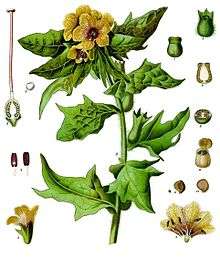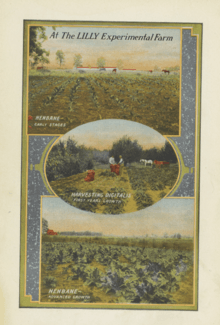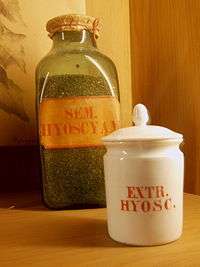Hyoscyamus niger
Hyoscyamus niger, commonly known as henbane, black henbane or stinking nightshade, is a poisonous plant in the family Solanaceae.[1]
| Henbane | |
|---|---|
 | |
| Hyoscyamus niger in Köhler's Medicinal Plants, 1887 | |
| Scientific classification | |
| Kingdom: | Plantae |
| Clade: | Tracheophytes |
| Clade: | Angiosperms |
| Clade: | Eudicots |
| Clade: | Asterids |
| Order: | Solanales |
| Family: | Solanaceae |
| Genus: | Hyoscyamus |
| Species: | H. niger |
| Binomial name | |
| Hyoscyamus niger | |
Historical use
The name henbane dates at least to AD 1265. The origins of the word are unclear, but "hen" probably originally meant death rather than referring to chickens.[2] Other etymologies of the word associate it with the Indo-European stem *bhelena whose hypothetical meaning is 'crazy plant'[3] and with the Proto-Germanic element bil meaning ‘vision, hallucination; magical power, miraculous ability’.[4]
Henbane was historically used in combination with other plants, such as mandrake, deadly nightshade, and datura, as an anaesthetic potion, as well as for its psychoactive properties in "magic brews".[1][5][6] These psychoactive properties include visual hallucinations and a sensation of flight.[7] It was originally used in continental Europe, Asia, and the Arab world,[8] though it did spread to England in the Middle Ages. The use of henbane by the ancient Greeks was documented by Pliny who said it was "of the nature of wine and therefore offensive to the understanding", and by Dioscorides who recommended it as a sedative and analgesic.[9] The plant, recorded as Herba Apollinaris, was used to yield oracles by the priestesses of Apollo.[1] Recently evidence for its earlier use in the Scottish Neolithic has been debated.[10] John Gerard's Herball states: "The leaves, the seeds and the juice, when taken internally cause an unquiet sleep, like unto the sleep of drunkenness, which continueth long and is deadly to the patient. To wash the feet in a decoction of Henbane, as also the often smelling of the flowers causeth sleep."[9]
The plant was also purportedly used as a fumigant for magical purposes. Albertus Magnus, in his work De Vegetalibus (1250), reported that necromancers used henbane to invoke the souls of the dead as well as demons.[11] Henbane was already being demonized as early as the Late Middle Ages when it became inseparably associated with witchcraft and malefic practices. “The witches drank the decoction of henbane and had those dreams for which they were tortured and executed. It was also used for witches’ ointments and was used for making weather and conjuring spirits. If there were a great drought then a stalk of henbane would be dipped into a spring, then the sun-baked sand would be sprinkled with this” (Perger 1864, 181).[11] During a Pomeranian witchcraft trial in 1538, a suspected witch "confessed" that she had given a man henbane seeds so that he would run around "crazy" (sexually aroused). In a file from an Inquisition trial, it was noted that "a witch admits" having once strewn henbane seeds between two lovers and uttering the following formula: "Here I sow wild seed, and the devil advised that they would hate and avoid each other until these seeds had been separated" (Marzell 1922, 169).[11]
Henbane was one of the ingredients in gruit, traditionally used in beers as a flavouring. Several cities, most notably Pilsen, were named after its German name "Bilsenkraut" in the context of its production for beer flavouring.[12] The recipe for henbane beer includes 40 g dried chopped henbane herbage, 5 g bayberry, 23 l water, 1 l brewing malt, 900 g honey, 5 g dried yeast, and brown sugar.[11] Henbane fell out of usage for beer when it was replaced by hops in the 11th to 16th centuries, as the Bavarian Purity Law of 1516 outlawed ingredients other than barley, hops, yeast, and water.[13]
Henbane is sometimes identified with the "hebenon" poured into the ear of Hamlet's father,[5][14] although other candidates for hebenon exist.[15]
Theories
Henbane seeds have been found in a Viking grave near Fyrkat, Denmark, that was first described in 1977.[16][17][17] This and other archaeological finds show that H. niger was known to the Vikings. Analysis of the symptoms caused by intoxication of this plant suggest that it may have been used by berserkers to induce the rage state that they used in war.[18]
Cultivation and use

Henbane originated in Eurasia, and is now globally distributed[1] as a plant grown mainly for pharmaceutical purposes. Henbane is rare in northern Europe; its cultivation for medicinal use is spread and legal in central and eastern Europe and in India. Henbane is an endangered plant according to the World Conservation Union's Red List.[11]
Henbane is used in traditional herbal medicine for ailments of the bones, rheumatism, toothache, asthma, cough, nervous diseases, and stomach pain. It might also be used as analgesic, sedative, and narcotic in some cultures. Adhesive bandages with henbane extract behind the ear are reported to prevent discomfort in travel-sick people. Henbane oil is used for medicinal massage.[11][19]
Henbane material in most Western countries can be bought in pharmacies with a prescription only. Sales of henbane oil are not legally regulated and are allowed in shops other than pharmacies in the US.[11]
Preparation, dosage, toxicity
Henbane leaves and herbage without roots are chopped and dried and are then used for medicinal purposes or in incense and smoking blends, in making beer and tea, and in seasoning wine. Henbane leaves are boiled in oil to derive henbane oil. Henbane seeds are an ingredient in incense blends.[11] In all preparations, the dosage has to be carefully estimated due to the high toxicity of henbane. For some therapeutic applications, dosages like 0.5 g and 1.5– 3 g were used. The lethal dosage is not known.[19]
Henbane is toxic to cattle, wild animals, fish, and birds.[11] Not all animals are susceptible; for example, the larvae of some Lepidoptera species, including cabbage moths, eat henbane. Pigs are immune to henbane toxicity and are reported to enjoy the effects of the plant.[11]
Psychoactive material
Hyoscyamine, scopolamine, and other tropane alkaloids have been found in the foliage and seeds of the plant.[1] The standard alkaloid content has been reported to be 0.03% to 0.28%.[11]
Effects
Henbane ingestion by humans is followed simultaneously by peripheral inhibition and central stimulation.[11] Common effects of henbane ingestion include hallucinations,[1] dilated pupils, restlessness, and flushed skin. Less common effects are tachycardia, convulsions, vomiting, hypertension, hyperpyrexia, and ataxia.[1] Initial effects typically last for three to four hours, while aftereffects may last up to three days. The side effects of henbane ingestion are dryness in the mouth, confusion, locomotor and memory disturbances, and farsightedness. Overdosages result in delirium, coma, respiratory paralysis, and death. Low and average dosages have inebriating and aphrodisiac effects.[11][19]
In his book How Do Witches Fly?, Alexander Kuklin refers to an experience of black henbane had by German scientist Michael Schenck.[20] Schenck recollected his experience:
The henbane's first effect was purely physical discomfort. My limbs lost certainty, pains hammered in my head, and I began to feel extremely giddy....I went to the mirror and was able to distinguish my face, but more dimly than normal. It looked flushed and must have been so. I had the feeling that my head had increased in size: it seemed to have grown broader, more solid, heavier, and I imagined that it was enveloped in firmer, thicker skin. The mirror itself seemed to be swaying, and I found it difficult to keep my face within its frame. The black discs of my pupils were immensely enlarged, as though the whole iris, which was normally blue, had become black. Despite of' the dilation of my pupils I could see no better than usual; quite the contrary, the outlines of objects were hazy, the window and the window frame were obscured by a thin mist.
Schenck's pulse became rapid and he experienced a further increase in the hallucinogenic effects of the plant:
There were animals which looked at me keenly with contorted grimaces and staring, terrified eyes; there were terrifying stones and clouds of mist, all sweeping along in the same direction. They carried me irresistibly with them. Their coloring must be described - but it was not a pure hue. They enveloped in a vague gray light, which emitted a dull glow and rolled onward and upward into a black and smoky sky. I was flung into a flaring drunkenness, a witches' cauldron of madness. Above my head water was flowing, dark and blood-red. The sky was filled with herds of animals. Fluid, formless creatures emerged from the darkness. I heard words, but they were all wrong and nonsensical, and yet they possessed for me some hidden meaning.[20]
Misidentification

Celebrity chef Antony Worrall Thompson accidentally recommended henbane as a "tasty addition to salads" in the August 2008 issue of Healthy and Organic Living magazine. The publication promptly warned subscribers against consuming the "very toxic" plant upon discovery of the error, and Thompson admitted to confusing it with fat hen, a member of the spinach family.[21]
Gallery
 Large flowering henbane
Large flowering henbane Henbane in flower
Henbane in flower Close-up of flower
Close-up of flower Henbane fruits
Henbane fruits Henbane seeds
Henbane seeds
References
- Roberts 1998, p. 31
- Anatoly Liberman, J. Lawrence Mitchell (2008). An Analytic Dictionary of English Etymology: An Introduction. U of Minnesota Press. pp. 108–110. ISBN 978-0-8166-5272-3.
- Hoops, J. (1973). Bilsenkraut. Reallexikon der germanischen Altertumskunde. pp. 1:284.
- de Vries, H. (1993). Heilige bäume, bilsenkraut und bildzeitung. In Naturverehrung und Heilkunst, ed. C. Raetsch: Suedergellersen, Germany: Verlag Bruno Martin. pp. 65–83.
- Anthony John Carter MB FFARCS (March 2003). "Myths and mandrakes" (PDF). Journal of the Royal Society of Medicine. 96 (3): 144–147. doi:10.1258/jrsm.96.3.144. PMC 539425. PMID 12612119.
- A. J. Carter (1996-12-21). "Narcosis and nightshade". British Medical Journal. 313 (7072): 1630–1632. doi:10.1136/bmj.313.7072.1630. PMC 2359130. PMID 8991015.
- Schultes & Smith 1976, p. 22
- Joseph Perez, Janet Lloyd, The Spanish Inquisition, Yale University Press, 2006, ISBN 0-300-11982-8, ISBN 978-0-300-11982-4, p229 footnote 10]
- Grieve, Maud (1971). A Modern Herbal: The Medicinal, Culinary, Cosmetic and Economic Properties, Cultivation and Folk-lore of Herbs, Grasses, Fungi, Shrubs, & Trees with All Their Modern Scientific Uses, Volume 1.
- Black Henbane (Hyoscyamus niger L.) in the Scottish Neolithic, Journal of Archaeological Science (1999) 26, 45–52
- Raetsch, Ch. (2005). The encyclopedia of psychoactive plants: ethnopharmacology and its applications. US: Park Street Press. pp. 277–282.
- Christian Rätsch (2015-07-29). "Urbock oder echtes Bier" (in German). Retrieved 2015-08-26.
Diese ehemaligen Anpflanzungen leben in verschiedenen Ortbezeichnungen bis heute fort, z.B. Bilsensee, Billendorf, Bilsengarten und vor allem im böhmischen Pilsen. So hat die Stadt, nach der unser modernes, stark gehopftes Bier »Pilsner« heißt, seinen Namen selbst vom Bilsenkraut, das dem echten »Pilsener Bier«, nämlich dem Bilsenkraut-Bier seinen Namen verlieh! In der Schweiz lebt der alte Name pilsener krut in der Bezeichnung Pilsenkraut bis heute fort.
- Dan Rabin, Carl Forget (1998). The Dictionary of Beer and Brewing. Taylor & Francis. xii. ISBN 978-1-57958-078-0.
- "Hebenon". Webster's Revised Unabridged Dictionary (1913 + 1828). Archived from the original on 2009-07-24.
- Anatoly Liberman, J. Lawrence Mitchell (2008). An Analytic Dictionary of English Etymology: An Introduction. U of Minnesota Press. pp. 110–111. ISBN 978-0-8166-5272-3.
- S., Price, Neil (2002). The Viking way : religion and war in late Iron Age Scandinavia. Uppsala universitet. Uppsala: Dept. of Archaeology and Ancient History. ISBN 978-9150616262. OCLC 52987118.
- Pentz, Peter; Baastrup Panum, Maria; Karg, Sabine; Mannering, Ulla (2009). "Kong Haralds vølve". Nationalmuseets Arbejdsmark: 215–232.
Da graven og gravpladsen blev beskrevet første gang (1977)....
- Fatur, Karsten (2019-11-15). "Sagas of the Solanaceae: Speculative ethnobotanical perspectives on the Norse berserkers". Journal of Ethnopharmacology. 244: 112151. doi:10.1016/j.jep.2019.112151. ISSN 0378-8741. PMID 31404578.
- Lindequist, U. (1993). Hyoscyamus. In Haegers Handbuch der pharmazeutischen Praxis, 5th ed., 5.: Berlin: Springer. pp. 460–74.CS1 maint: location (link)
- Kuklin, Alexander (February 1999). How Do Witches Fly?. DNA Press. ISBN 0-9664027-0-7.
- Dawar, Anil (August 4, 2008). "TV chef Worrall Thompson recommends deadly weed as salad ingredient". The Guardian. London. Retrieved 2008-08-04.
- General
- Roberts, Margaret F.; Wink, Michael (1998). Alkaloids: biochemistry, ecology, and medicinal applications. Springer. pp. 31–32. ISBN 978-0-306-45465-3. Retrieved 2006-12-27.
- "Henbane". Clinicalmind.com. Archived from the original on 2007-09-27. Retrieved 2007-08-18.